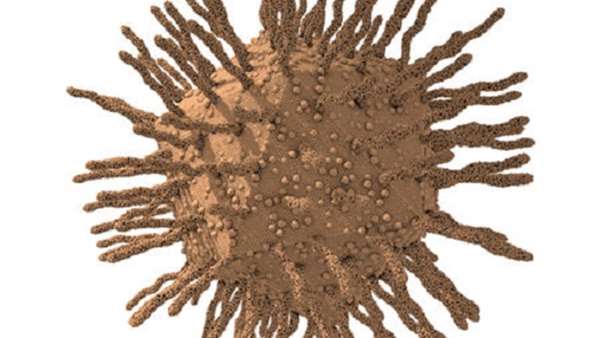Scientists engineer a virus to take out cancer cells and their accomplices
Part of what makes carcinoma cells, the most common kind of cancer cell, so potent and deadly is the helping hand they receive from their neighbors. Known as cancer-associated fibroblasts, these nearby cells aid and abet the sinister machinations of the mutating cancer cells by shielding them from the bodys immune system.
Part of what makes carcinoma cells, the most common kind of cancer cell, so potent and deadly is the helping hand they receive from their neighbors. Known as cancer-associated fibroblasts, these nearby cells aid and abet the sinister machinations of the mutating cancer cells by shielding them from the body"s immune system. Scientists have now developed a pioneering two-pronged virus that can target both, a new tool they describe as the first-of-its-kind.
Among the several promising aspects of this new research is the fact that it is based on a virus already in use in clinical trials. Called enadenotucirev, the virus has been bred to infect only cancer cells and leave healthy cells untouched as a way of treating carcinomas, and promising early resultssuggest it may give the body"s natural immune response a boost along the way.
Scientists at the University of Oxford looked to equip enadenotucirev with more cancer-fighting potential by making some alterations. Their modified version of the virus include genetic instructions that prompt infected cancer calls to produce a special type of protein called a bispecific T-cell engager.
This protein is what joins the dots, literally binding to the cancer-associated fibroblasts at one end and powerful immune T-cells at the other. This marriage quickly achieves results as the T-cells go about killing off the attached fibroblasts.
"We hijacked the virus"s machinery so the T-cell engager would be made only in infected cancer cells and nowhere else in the body," says Dr Joshua Freedman, from the Department of Oncology at the University of Oxford, first author on the study. "The T-cell engager molecule is so powerful that it can activate immune cells inside the tumor, which are being suppressed by the cancer, to attack the fibroblasts."
The scientists say this marks the first time that cancer-associated fibroblasts within solid tumors have been targeted in this way, but it is still early days for the promising technology. Their work so far has only demonstrated its cancer-killing properties in mice and in human cancer cell samples in the lab, and when it comes to translating those results to the human body there are a lot of unknowns.
For example, therapies that have been developed to target the cancer-associated fibroblasts also carry the risk of killing other innocent fibroblasts around the body. Though there are plenty of other uncertainties around how the human body would respond to the treatment, the scientists say there a some positive signs regarding this particular side effect.
Their experiments put the virus to work against solid prostate cancer tumor samples along with healthy bone marrow, and they found that it caused no toxicity or unwanted T-cell activation in healthy regions. And given that enadenotucirev is already undergoing trials in humans, there is hope that their modified version could also reach clinical trials as soon as next year.
"Even when most of the cancer cells in a carcinoma are killed, fibroblasts can protect the residual cancer cells and help them to recover and flourish," says Dr Kerry Fisher, from the Department of Oncology at the University of Oxford. "Until now, there has not been any way to kill both cancer cells and the fibroblasts protecting them at the same time, without harming the rest of the body. Our new technique to simultaneously target the fibroblasts while killing cancer cells with the virus could be an important step towards reducing immune system suppression within carcinomas and should kick-start the normal immune process."
Reference: http://cancerres.aacrjournals.org/content/early/2018/11/15/0008-5472.CAN-18-1750





ارسال به دوستان